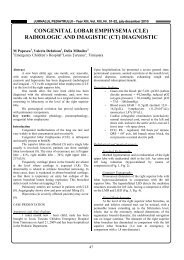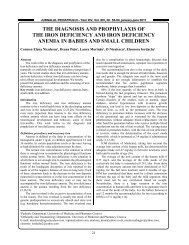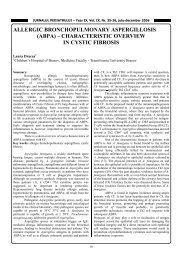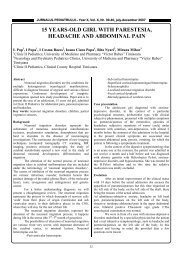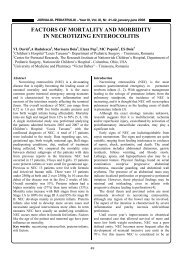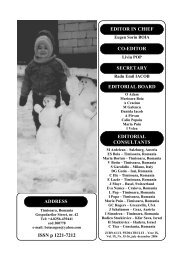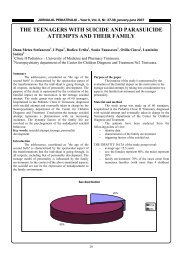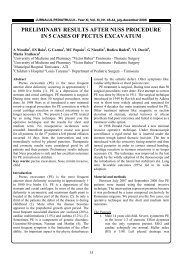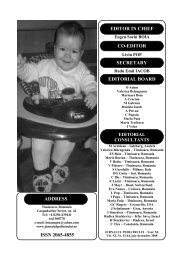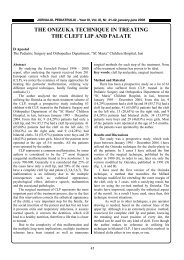address editor in chief co-editors secretary editorial board
address editor in chief co-editors secretary editorial board
address editor in chief co-editors secretary editorial board
Create successful ePaper yourself
Turn your PDF publications into a flip-book with our unique Google optimized e-Paper software.
JURNALUL PEDIATRULUI – Year XV, X<br />
, Vol. XV, Nr. 59-60<br />
60, , july<br />
j<br />
uly-december 2012<br />
ECHOGRAPHIC FOLLOW-UP OF REFLUX STATUS IN A<br />
CHILD WITH NEUROGENIC BLADDER AND<br />
INTERMITTENT VESICAL CATHETERIZATION<br />
Camelia Daescu 1,2 , Adela Chirita Emandi 1,2 , C Popoiu 1,2 ,<br />
A Craciun 1,2 , Andreea Militaru 1,2 , Oana Belei 1,2<br />
Abstract<br />
Objectives: We highlight the role of echography <strong>in</strong> the<br />
follow-up of an 8 year old girl with neurogenic bladder,<br />
right megaureter due to reflux; left obstructive megaureter,<br />
and impaired renal function.<br />
Methods: The patient came quarterly to follow-up, to<br />
evaluate renal function and possible <strong>in</strong>fections, while the<br />
hydronephrosis was evaluated by echography. She had<br />
<strong>in</strong>termittent vesical catheterization and antibiotic<br />
prophylaxis.<br />
Results: The girl was diagnosed at 3 months of age<br />
with <strong>co</strong>mplex renal malformation, one month later she<br />
underwent bilateral cutaneous ureterostomy. Ureteral<br />
reimplantation surgery was performed at the age of 1 year<br />
and 6 months. At age 6, abdom<strong>in</strong>al echography revealed<br />
bilateral hidronephrosis grade IV, which was susta<strong>in</strong>ed by<br />
uroMRI and stage 2 renal failure shown by renal function<br />
tests. Intermittent vesical catheterization 4 times/day and<br />
antibiotic prophylaxis were <strong>in</strong>itiated. The echographic<br />
follow-up reported that the reflux rema<strong>in</strong>ed mostly<br />
unchanged: left kidney had hydronephosis grade III, and the<br />
right kidney presented hydronephosis grade III/IV.<br />
Nevertheless the parenchymatous <strong>in</strong>dex <strong>in</strong>creased, which<br />
<strong>co</strong>rrelates with the improved renal function, from stage 2<br />
renal failure (moderate reduction <strong>in</strong> glomerular filtration<br />
rate=58mL/m<strong>in</strong>/1.73m2) to normal glomerular filtration<br />
rate. The blood urea nitrogen and creat<strong>in</strong><strong>in</strong>e levels slightly<br />
decreased. The ur<strong>in</strong>ary tract <strong>in</strong>fection rate rema<strong>in</strong>ed low.<br />
Conclusions: Long-term <strong>in</strong>termittent catheterization as<br />
method of treatment and prevention is associated with stable<br />
reflux status, renal function, and <strong>in</strong>fection rate, which <strong>in</strong> the<br />
end result <strong>in</strong> better quality of life for the patient.<br />
Echographic method of follow-up is reliable for medical<br />
exam<strong>in</strong>ations s<strong>in</strong>ce it is <strong>in</strong>formative, harmless and<br />
e<strong>co</strong>nomical.<br />
Key words: Echographic follow-up; child; <strong>in</strong>termittent<br />
vesical catheterization<br />
Background<br />
The ur<strong>in</strong>ary <strong>co</strong>mplications of patients with a<br />
neuropathic bladder <strong>co</strong>nsist of <strong>in</strong><strong>co</strong>nt<strong>in</strong>ence, <strong>in</strong>ability to<br />
empty the bladder, ur<strong>in</strong>ary <strong>in</strong>fection, and deterioration of the<br />
upper ur<strong>in</strong>ary tract. Intermittent self-catheterization (ISC) or<br />
carer/nurse-assisted cl<strong>in</strong>ically clean <strong>in</strong>termittent<br />
catheterization (CIC) has developed over the past 30 years<br />
as a means of treat<strong>in</strong>g patients with bladder-empty<strong>in</strong>g<br />
problems. It is now re<strong>co</strong>gnized as one of the safest methods<br />
of manag<strong>in</strong>g patients, especially those with neurogenic<br />
bladder disorders (1). CIC has been demonstrated to reduce<br />
<strong>in</strong>fection hazards and greatly improve the lives of many<br />
patients with micturition disorders. In 1972, Lapides et al<br />
(2) reported the successful treatment of neuropathic bladders<br />
with CIC and s<strong>in</strong>ce then CIC has be<strong>co</strong>me widely accepted as<br />
the ma<strong>in</strong> therapeutic management for patients with such<br />
bladders. CIC can be undertaken by health professionals <strong>in</strong> a<br />
variety of cl<strong>in</strong>ical sett<strong>in</strong>gs for a range of cl<strong>in</strong>ical <strong>in</strong>dications,<br />
and <strong>in</strong>creas<strong>in</strong>gly by patients themselves who use it as a<br />
long-term bladder management technique. The relative<br />
simplicity of the technique <strong>co</strong>mes with the potential for<br />
health professionals to underestimate the skills required<br />
when <strong>co</strong>nsider<strong>in</strong>g a regimen of <strong>in</strong>termittent catheterisation<br />
and, perhaps more importantly, to underestimate the impact<br />
it may have on <strong>in</strong>dividual patients (3). Adequate bladder<br />
empty<strong>in</strong>g can be achieved by CIC, but ur<strong>in</strong>ary <strong>in</strong><strong>co</strong>nt<strong>in</strong>ence<br />
may persist <strong>in</strong> the presence of detrusor hyperreflexia and/or<br />
low <strong>co</strong>mpliance bladder.<br />
Objectives<br />
To highlight the role of echography <strong>in</strong> the follow-up of<br />
an 8 year old girl with neurogenic bladder, right megaureter<br />
due to reflux; left obstructive megaureter, and impaired<br />
renal function.<br />
Case report<br />
History<br />
We present an 8 years old girl that we have <strong>in</strong><br />
management, <strong>in</strong> the Nephrology department of Emergency<br />
Hospital for Children “Louis Turcanu” <strong>in</strong> Timisoara. The<br />
child is the first born of healthy non-<strong>co</strong>nsangu<strong>in</strong>eous<br />
parents. There was no family history of similar symptoms.<br />
1 University of Medic<strong>in</strong>e and Pharmacy “Victor Babes” Timisoara<br />
2 Emergency Hospital for Children “Louis Turcanu” Timisoara<br />
E-mail: camidaescu@yahoo.<strong>co</strong>m, adela.chirita@yahoo.<strong>co</strong>m, mcpopoiu@yahoo.<strong>co</strong>m, ad_craciun@yahoo.<strong>co</strong>.uk,<br />
andreamilitaru@yahoo.<strong>co</strong>m, oana22_99@yahoo.<strong>co</strong>m<br />
14



